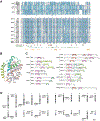SOXopathies: Growing Family of Developmental Disorders Due to SOX Mutations
- PMID: 31288943
- PMCID: PMC6956857
- DOI: 10.1016/j.tig.2019.06.003
SOXopathies: Growing Family of Developmental Disorders Due to SOX Mutations
Abstract
The SRY-related (SOX) transcription factor family pivotally contributes to determining cell fate and identity in many lineages. Since the original discovery that SRY deletions cause sex reversal, mutations in half of the 20 human SOX genes have been associated with rare congenital disorders, henceforward called SOXopathies. Mutations are generally de novo, heterozygous, and inactivating, revealing gene haploinsufficiency, but other types, including duplications, have been reported too. Missense variants primarily target the HMG domain, the SOX hallmark that mediates DNA binding and bending, nuclear trafficking, and protein-protein interactions. We here review key clinical and molecular features of SOXopathies and discuss the prospect that the disease family likely involves more SOX genes and larger clinical and genetic spectrums than currently appreciated.
Keywords: SOX; SRY; developmental disorder; genetic variant; human disease; mutation.
Copyright © 2019 Elsevier Ltd. All rights reserved.
Figures




Similar articles
-
De Novo SOX6 Variants Cause a Neurodevelopmental Syndrome Associated with ADHD, Craniosynostosis, and Osteochondromas.Am J Hum Genet. 2020 Jun 4;106(6):830-845. doi: 10.1016/j.ajhg.2020.04.015. Epub 2020 May 21. Am J Hum Genet. 2020. PMID: 32442410 Free PMC article.
-
The early history of the Sox genes.Int J Biochem Cell Biol. 2010 Mar;42(3):378-80. doi: 10.1016/j.biocel.2009.12.003. Epub 2009 Dec 31. Int J Biochem Cell Biol. 2010. PMID: 20005971
-
SOX genes: architects of development.Mol Med. 1996 Jul;2(4):405-12. Mol Med. 1996. PMID: 8827711 Free PMC article. Review.
-
De Novo SOX4 Variants Cause a Neurodevelopmental Disease Associated with Mild Dysmorphism.Am J Hum Genet. 2019 Feb 7;104(2):246-259. doi: 10.1016/j.ajhg.2018.12.014. Epub 2019 Jan 17. Am J Hum Genet. 2019. PMID: 30661772 Free PMC article.
-
The SOX gene family: function and regulation in testis determination and male fertility maintenance.Mol Biol Rep. 2013 Mar;40(3):2187-94. doi: 10.1007/s11033-012-2279-3. Epub 2012 Nov 27. Mol Biol Rep. 2013. PMID: 23184044 Review.
Cited by
-
Landscape of Constitutional SOX4 Variation in Human Disorders.Genes (Basel). 2024 Jan 25;15(2):158. doi: 10.3390/genes15020158. Genes (Basel). 2024. PMID: 38397148 Free PMC article. Review.
-
Mapping the epigenomic landscape of post-traumatic stress disorder in human cortical neurons.medRxiv [Preprint]. 2024 Oct 16:2024.10.11.24315258. doi: 10.1101/2024.10.11.24315258. medRxiv. 2024. PMID: 39484232 Free PMC article. Preprint.
-
SOX10: 20 years of phenotypic plurality and current understanding of its developmental function.J Med Genet. 2022 Feb;59(2):105-114. doi: 10.1136/jmedgenet-2021-108105. Epub 2021 Oct 19. J Med Genet. 2022. PMID: 34667088 Free PMC article. Review.
-
Involvement of Sox9a in chondrogenesis and gonadal development in teleost Nile tilapia ( Oreochromis niloticus).Zool Res. 2023 Jul 18;44(4):729-731. doi: 10.24272/j.issn.2095-8137.2023.024. Zool Res. 2023. PMID: 37161654 Free PMC article. No abstract available.
-
The Role of SOX2 and SOX9 in Radioresistance and Tumor Recurrence.Cancers (Basel). 2024 Jan 19;16(2):439. doi: 10.3390/cancers16020439. Cancers (Basel). 2024. PMID: 38275880 Free PMC article.
References
-
- Gonen N and Lovell-Badge R, The regulation of Sox9 expression in the gonad. Curr Top Dev Biol, 2019. 134: p. 223–252. - PubMed
-
- Schepers GE, Teasdale RD, and Koopman P, Twenty pairs of sox: extent, homology, and nomenclature of the mouse and human sox transcription factor gene families. Dev Cell, 2002. 3(2): p. 167–70. - PubMed
-
- Kamachi Y and Kondoh H, Sox proteins: regulators of cell fate specification and differentiation. Development, 2013. 140(20): p. 4129–44. - PubMed
-
- Tajan M, et al., The RASopathy Family: Consequences of Germline Activation of the RAS/MAPK Pathway. Endocr Rev, 2018. 39(5): p. 676–700. - PubMed
-
- Jobling R, et al., The collagenopathies: review of clinical phenotypes and molecular correlations. Curr Rheumatol Rep, 2014. 16(1): p. 394. - PubMed
Publication types
MeSH terms
Substances
Grants and funding
LinkOut - more resources
Full Text Sources
Medical
Miscellaneous

